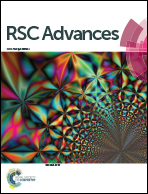Synthesis, crystal growth and characterization of di-valine maleic – a new nonlinear optical material†
Abstract
An amino acid salt di-valine maleic (VM) has been synthesized for the first time and single crystals were grown by the controlled evaporation of the aqueous solution at constant temperature (48 ± 0.03) °C. Crystal and molecular structure of VM was determined by single crystal X-ray diffraction analysis. X-ray crystallography reveals that VM possesses different two-dimensional supramolecular networks through hydrogen bonding interactions. Investigation of intermolecular interactions and crystal packing via Hirshfeld surface analysis clearly quantify the interactions within the crystal structure. The physicochemical properties of the grown crystal were characterized by thermal and optical analysis and measurement of hardness. The second harmonic generation efficiency of VM was investigated by powder method and found to be 0.3 times to KDP. The dipole moment, polarizability, first order hyperpolarizability and the HOMO–LUMO energy gap of VM were calculated using B3LYP functional and 6-31G(d,p) basis set to confirm the suitability of the crystal for nonlinear optical applications. First hyperpolarizability was found to be 5 times of urea.


 Please wait while we load your content...
Please wait while we load your content...